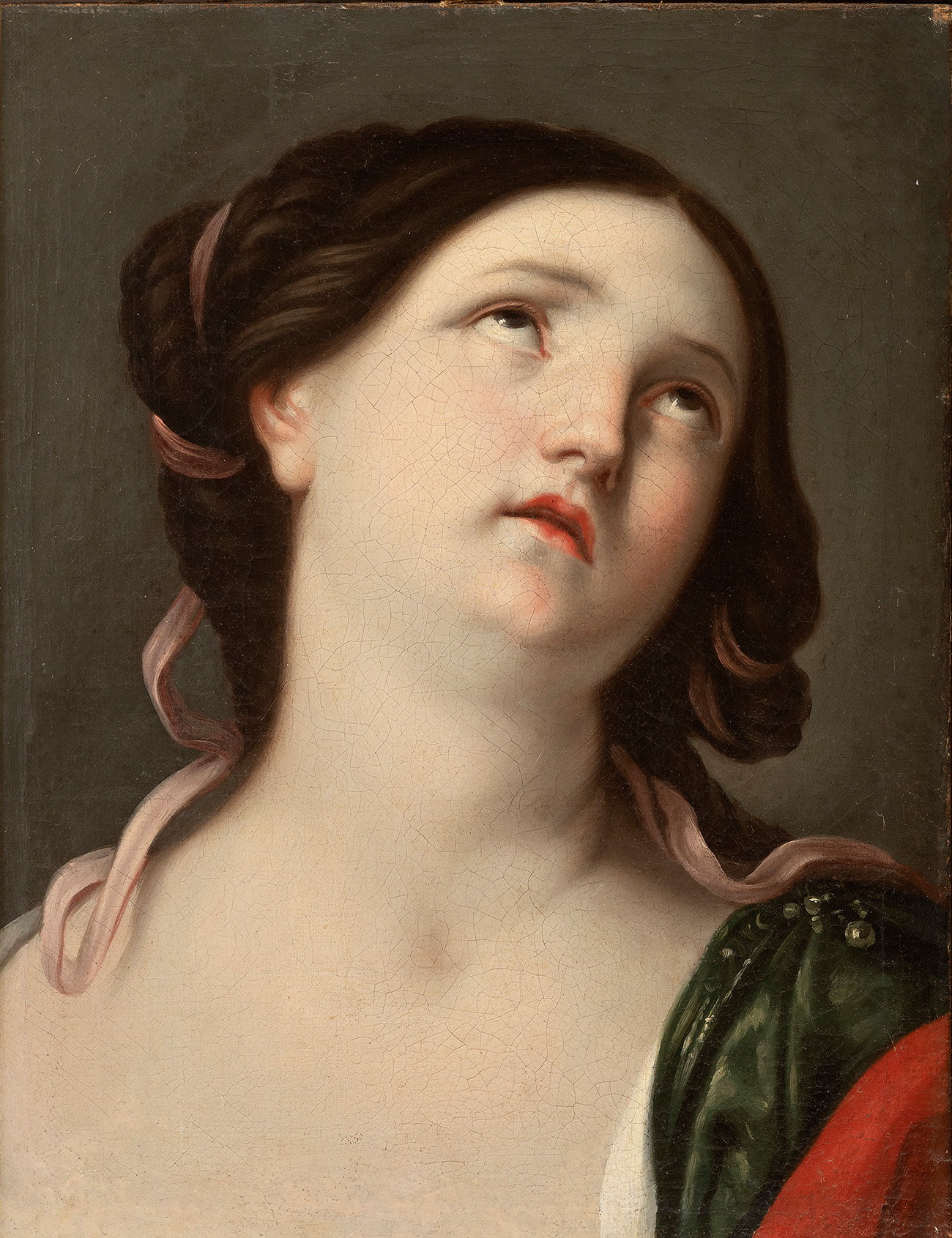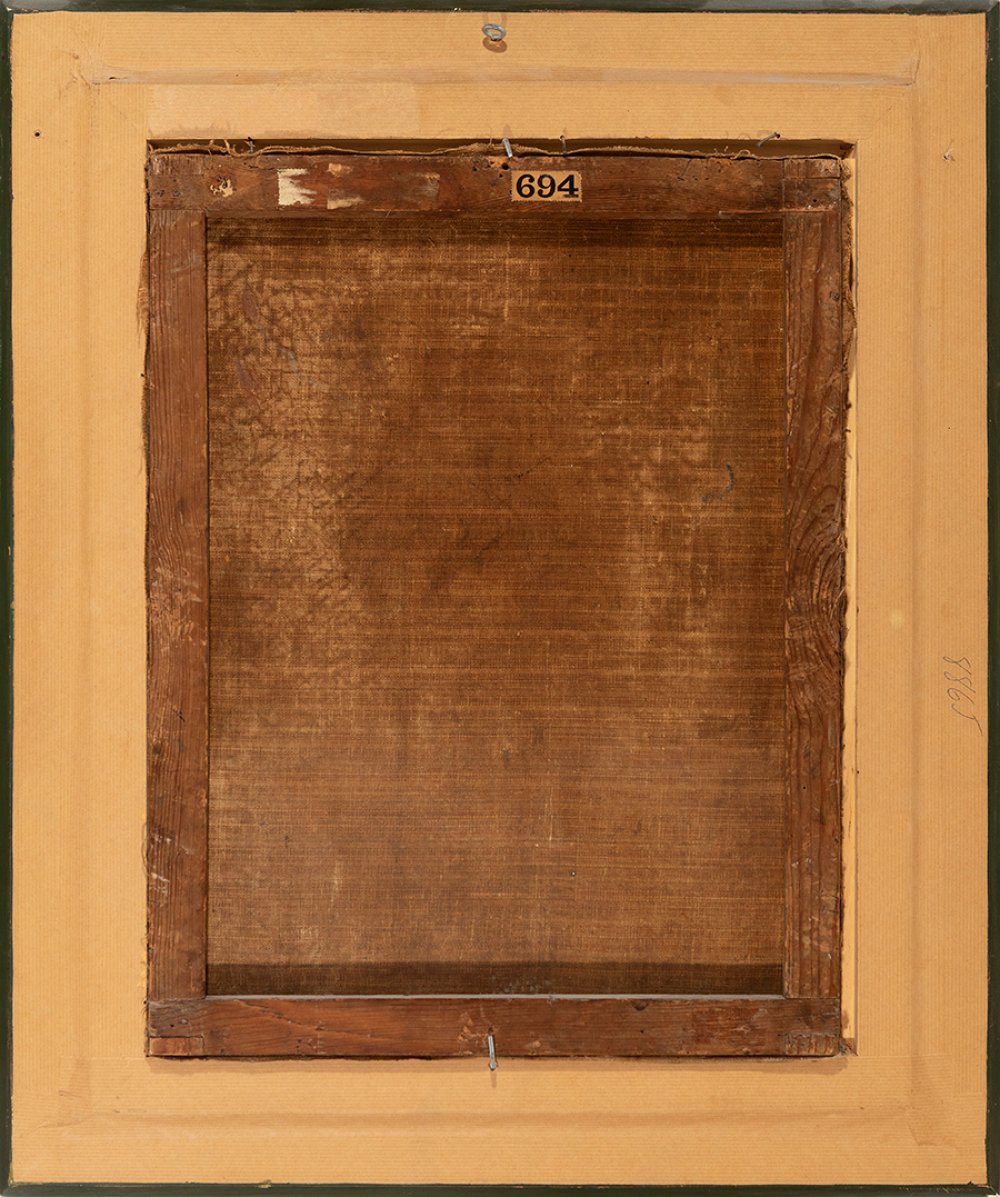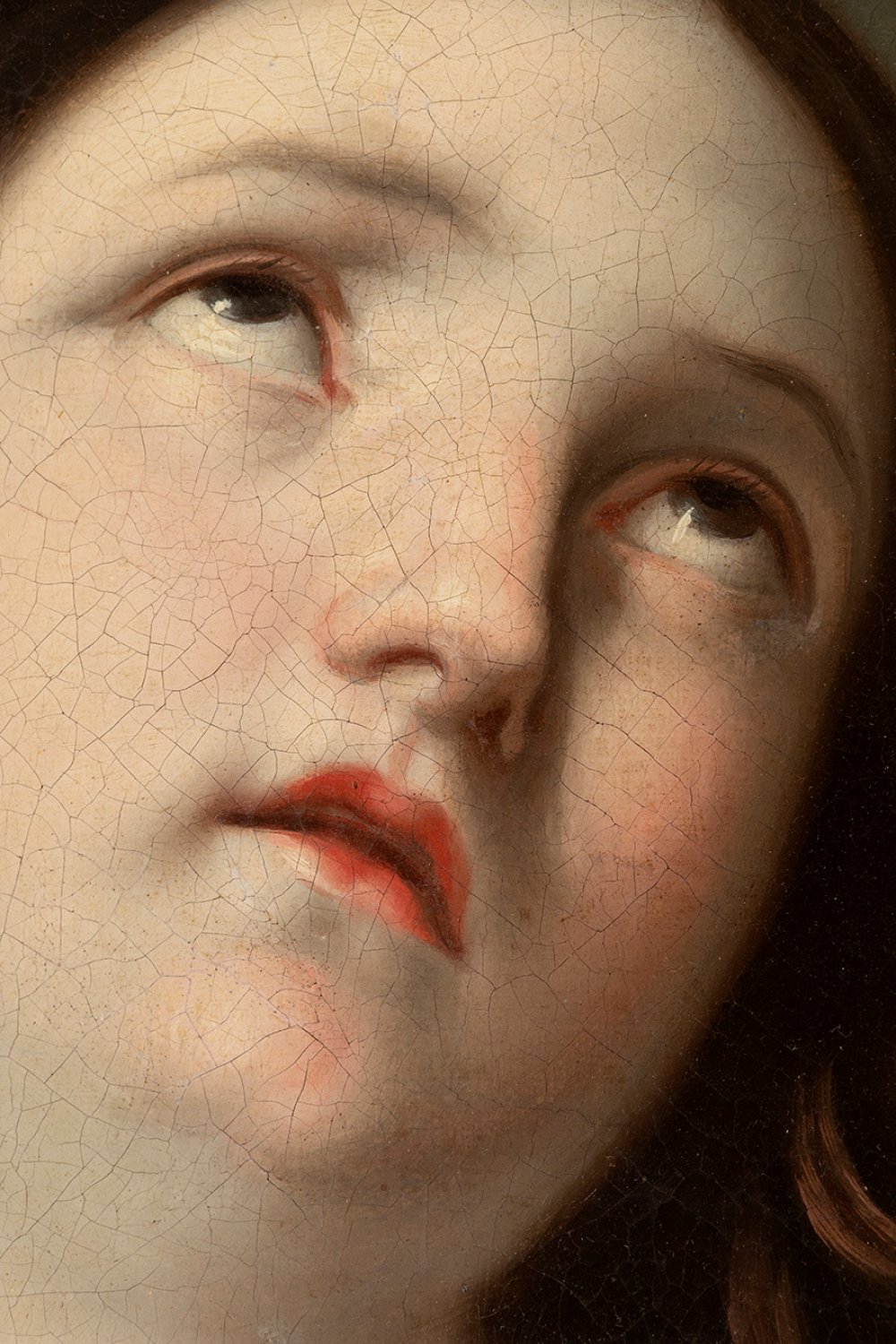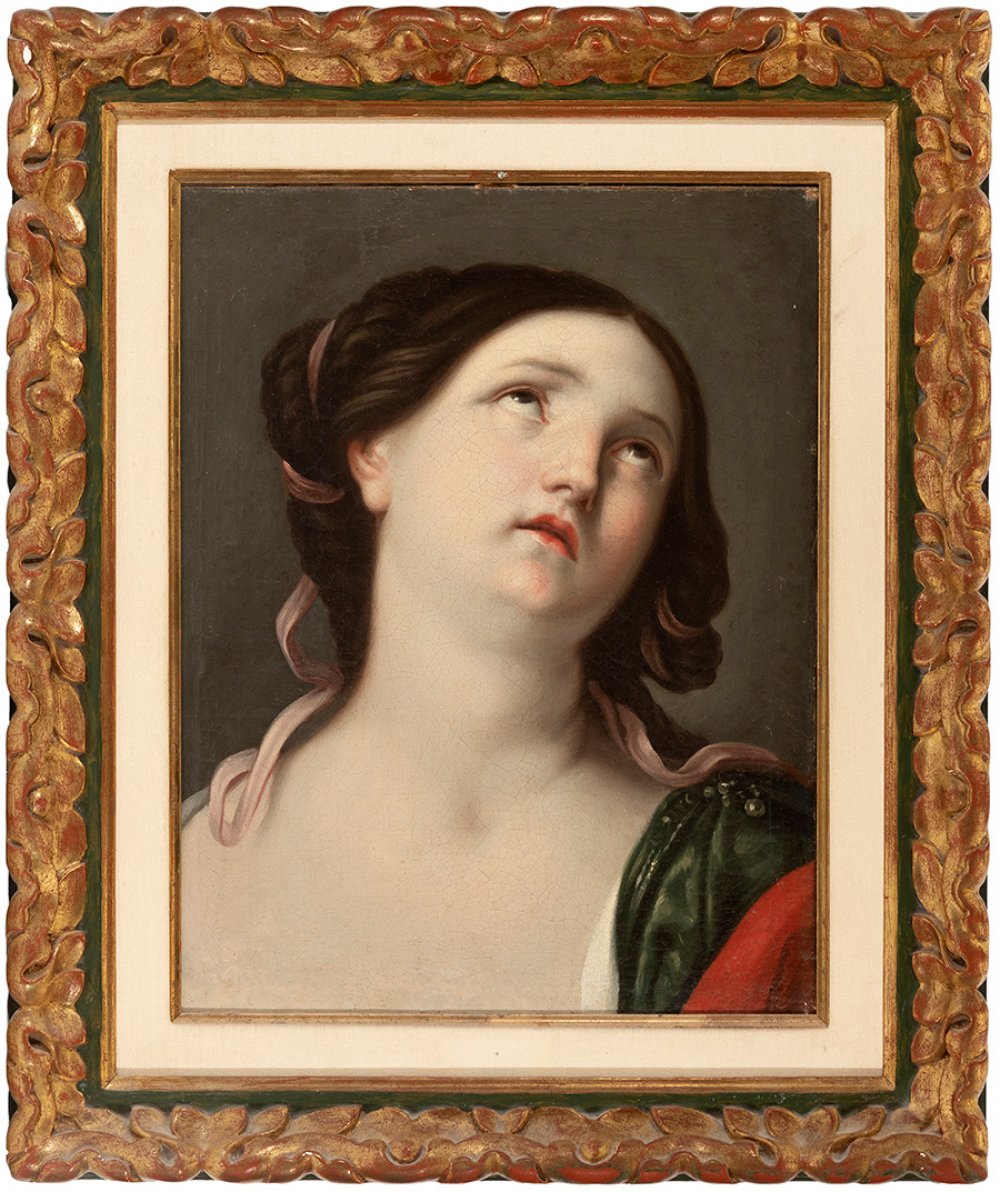18
Italian School of the 18th century, following models of GUIDO RENI."Lucretia Dying".Oil on canvas.
1/4
Description
Italian School of the 18th century, following models of GUIDO RENI.
"Lucretia Dying".
Oil on canvas.
Size: 48 x 37 cm; 65 x 56 cm (frame).
Work of anonymous author following the models of the work of Guido Reni "Lucrezia giving herself to death". which is kept in the Prado Museum. Although this one is smaller and the stiletto sticking into the chest is not visible.
The undisputed master of Roman-Bolognese classicism alongside Albani and Domenichino, Guido Reni was undoubtedly the best of the three. Closely linked to the Carracci family and to the city of Bologna, they all had a similar career. They trained in Bologna with Denys Calvaert, and then went on to the Accademia degli Incamminati, directed by Ludovico Carraci. In 1600 Reni arrived in Rome, where he worked with Annibale Carracci in the Galleria Farnese. His best period began in these years; in 1609, on Annibale's death, Reni became the head of the classicist school. In the city he was the protégé of Scipione Borghese, the future Pope Paul V, for whom the painter produced one of his most important works, "La Aurora" (Palazzo Rospigliosi). It reveals something that would always be characteristic of Reni's style, his admiration for ancient sculpture. Starting from classical statues, he developed an ideal of beauty and perfection that would be greatly admired by subsequent painters. In 1614 he returned to Bologna for good. Reni's style evolved in a clear direction, becoming more and more sculptural and cold, more and more fully classicist. His mature work was characterised by a cold, silvery palette. Finally, from the 1930s onwards, his style became sketchy, with an unfinished appearance and a tendency towards monochrome, of great interest from a technical as well as a formal point of view.Guido Reni is currently represented in the most important art galleries all over the world, including the Prado Museum, the Hermitage, the Louvre, the Metropolitan Museum in New York and the National Gallery in London, among many others.
"Lucretia Dying".
Oil on canvas.
Size: 48 x 37 cm; 65 x 56 cm (frame).
Work of anonymous author following the models of the work of Guido Reni "Lucrezia giving herself to death". which is kept in the Prado Museum. Although this one is smaller and the stiletto sticking into the chest is not visible.
The undisputed master of Roman-Bolognese classicism alongside Albani and Domenichino, Guido Reni was undoubtedly the best of the three. Closely linked to the Carracci family and to the city of Bologna, they all had a similar career. They trained in Bologna with Denys Calvaert, and then went on to the Accademia degli Incamminati, directed by Ludovico Carraci. In 1600 Reni arrived in Rome, where he worked with Annibale Carracci in the Galleria Farnese. His best period began in these years; in 1609, on Annibale's death, Reni became the head of the classicist school. In the city he was the protégé of Scipione Borghese, the future Pope Paul V, for whom the painter produced one of his most important works, "La Aurora" (Palazzo Rospigliosi). It reveals something that would always be characteristic of Reni's style, his admiration for ancient sculpture. Starting from classical statues, he developed an ideal of beauty and perfection that would be greatly admired by subsequent painters. In 1614 he returned to Bologna for good. Reni's style evolved in a clear direction, becoming more and more sculptural and cold, more and more fully classicist. His mature work was characterised by a cold, silvery palette. Finally, from the 1930s onwards, his style became sketchy, with an unfinished appearance and a tendency towards monochrome, of great interest from a technical as well as a formal point of view.Guido Reni is currently represented in the most important art galleries all over the world, including the Prado Museum, the Hermitage, the Louvre, the Metropolitan Museum in New York and the National Gallery in London, among many others.
Auction Details
Shipping
T&Cs & Important Info
Ask seller a question
Italian School of the 18th century, following models of GUIDO RENI.
"Lucretia Dying".
Oil on canvas.
Size: 48 x 37 cm; 65 x 56 cm (frame).
Work of anonymous author following the models of the work of Guido Reni "Lucrezia giving herself to death". which is kept in the Prado Museum. Although this one is smaller and the stiletto sticking into the chest is not visible.
The undisputed master of Roman-Bolognese classicism alongside Albani and Domenichino, Guido Reni was undoubtedly the best of the three. Closely linked to the Carracci family and to the city of Bologna, they all had a similar career. They trained in Bologna with Denys Calvaert, and then went on to the Accademia degli Incamminati, directed by Ludovico Carraci. In 1600 Reni arrived in Rome, where he worked with Annibale Carracci in the Galleria Farnese. His best period began in these years; in 1609, on Annibale's death, Reni became the head of the classicist school. In the city he was the protégé of Scipione Borghese, the future Pope Paul V, for whom the painter produced one of his most important works, "La Aurora" (Palazzo Rospigliosi). It reveals something that would always be characteristic of Reni's style, his admiration for ancient sculpture. Starting from classical statues, he developed an ideal of beauty and perfection that would be greatly admired by subsequent painters. In 1614 he returned to Bologna for good. Reni's style evolved in a clear direction, becoming more and more sculptural and cold, more and more fully classicist. His mature work was characterised by a cold, silvery palette. Finally, from the 1930s onwards, his style became sketchy, with an unfinished appearance and a tendency towards monochrome, of great interest from a technical as well as a formal point of view.Guido Reni is currently represented in the most important art galleries all over the world, including the Prado Museum, the Hermitage, the Louvre, the Metropolitan Museum in New York and the National Gallery in London, among many others.
"Lucretia Dying".
Oil on canvas.
Size: 48 x 37 cm; 65 x 56 cm (frame).
Work of anonymous author following the models of the work of Guido Reni "Lucrezia giving herself to death". which is kept in the Prado Museum. Although this one is smaller and the stiletto sticking into the chest is not visible.
The undisputed master of Roman-Bolognese classicism alongside Albani and Domenichino, Guido Reni was undoubtedly the best of the three. Closely linked to the Carracci family and to the city of Bologna, they all had a similar career. They trained in Bologna with Denys Calvaert, and then went on to the Accademia degli Incamminati, directed by Ludovico Carraci. In 1600 Reni arrived in Rome, where he worked with Annibale Carracci in the Galleria Farnese. His best period began in these years; in 1609, on Annibale's death, Reni became the head of the classicist school. In the city he was the protégé of Scipione Borghese, the future Pope Paul V, for whom the painter produced one of his most important works, "La Aurora" (Palazzo Rospigliosi). It reveals something that would always be characteristic of Reni's style, his admiration for ancient sculpture. Starting from classical statues, he developed an ideal of beauty and perfection that would be greatly admired by subsequent painters. In 1614 he returned to Bologna for good. Reni's style evolved in a clear direction, becoming more and more sculptural and cold, more and more fully classicist. His mature work was characterised by a cold, silvery palette. Finally, from the 1930s onwards, his style became sketchy, with an unfinished appearance and a tendency towards monochrome, of great interest from a technical as well as a formal point of view.Guido Reni is currently represented in the most important art galleries all over the world, including the Prado Museum, the Hermitage, the Louvre, the Metropolitan Museum in New York and the National Gallery in London, among many others.
29th December - Old Masters
Sale Date(s)
Venue Address
Aragón 346, Barcelona
Calle Velázquez 7, Madrid
Carrer de Cirilo Amorós 55, Valencia
Barcelona
08009
Spain
General delivery information available from the auctioneer
Setdart offers Worldwide shipping
PICK UP IN ROOM: You can come and pick up your lots in our offices (Barcelona, Madrid or Valencia). At the moment of the withdrawal, you will be able to accept the current conditions of the lot by means of a document that you will sign.
YOU CAN SEND ANOTHER PERSON TO PICK UP: This person must present a signed authorization that you can find in our web page by accessing from BUY AT SETDART- LOGISTICS-DOWNLOAD AUTHORIZATION DOCUMENT. You can also send an e-mail with the requested data in AUTHORIZATION DOCUMENT to admin@setdart.com
Important Information
25% buyer´s premium
21% buyer´s premium at www.setdart.com












